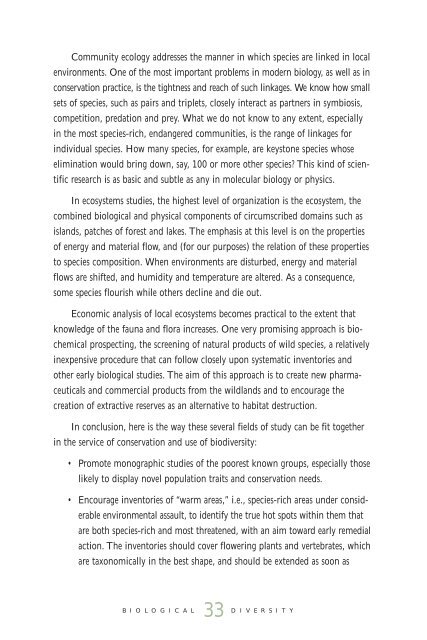Download Biological Diversity - New York State Museum
Download Biological Diversity - New York State Museum
Download Biological Diversity - New York State Museum
You also want an ePaper? Increase the reach of your titles
YUMPU automatically turns print PDFs into web optimized ePapers that Google loves.
Community ecology addresses the manner in which species are linked in local<br />
environments. One of the most important problems in modern biology, as well as in<br />
conservation practice, is the tightness and reach of such linkages. We know how small<br />
sets of species, such as pairs and triplets, closely interact as partners in symbiosis,<br />
competition, predation and prey. What we do not know to any extent, especially<br />
in the most species-rich, endangered communities, is the range of linkages for<br />
individual species. How many species, for example, are keystone species whose<br />
elimination would bring down, say, 100 or more other species? This kind of scientific<br />
research is as basic and subtle as any in molecular biology or physics.<br />
In ecosystems studies, the highest level of organization is the ecosystem, the<br />
combined biological and physical components of circumscribed domains such as<br />
islands, patches of forest and lakes. The emphasis at this level is on the properties<br />
of energy and material flow, and (for our purposes) the relation of these properties<br />
to species composition. When environments are disturbed, energy and material<br />
flows are shifted, and humidity and temperature are altered. As a consequence,<br />
some species flourish while others decline and die out.<br />
Economic analysis of local ecosystems becomes practical to the extent that<br />
knowledge of the fauna and flora increases. One very promising approach is biochemical<br />
prospecting, the screening of natural products of wild species, a relatively<br />
inexpensive procedure that can follow closely upon systematic inventories and<br />
other early biological studies. The aim of this approach is to create new pharmaceuticals<br />
and commercial products from the wildlands and to encourage the<br />
creation of extractive reserves as an alternative to habitat destruction.<br />
In conclusion, here is the way these several fields of study can be fit together<br />
in the service of conservation and use of biodiversity:<br />
• Promote monographic studies of the poorest known groups, especially those<br />
likely to display novel population traits and conservation needs.<br />
• Encourage inventories of “warm areas,” i.e., species-rich areas under considerable<br />
environmental assault, to identify the true hot spots within them that<br />
are both species-rich and most threatened, with an aim toward early remedial<br />
action. The inventories should cover flowering plants and vertebrates, which<br />
are taxonomically in the best shape, and should be extended as soon as<br />
B i o l o g i c a l<br />
33 D i v e r s i t y
















